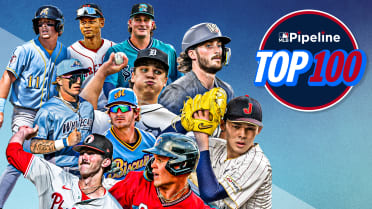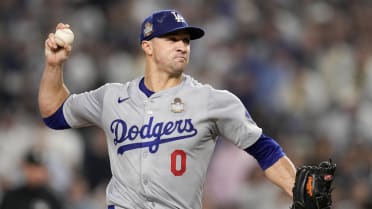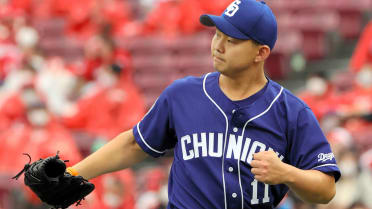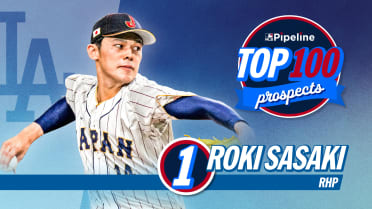Best players after age 45? It's a distinguished list
Bartolo Colon turned 45 today, and while you ponder the awesomeness of those words, we here at #ThrowbackThursday want to take a chance to celebrate by looking back at the 10 best players in baseball history from age 45 on.
First, a few words about age 45. By baseball years, 45 is not old. Forty is old. Forty-five is ancient. Just playing in the big leagues at age 45 is a big deal. Going back to 1901, only 22 position players have gotten even one at-bat after age 45. Only 20 pitchers have thrown even one inning after age 45. The point is that it is a physical miracle for a player to still be active in the Major Leagues at this age.
Colon may not look the part. But he's a physical marvel.
By going 10 deep on this list, we will get to a few players who weren't especially good after age 45. But they were good enough to play in the big leagues, and that's amazing in itself.
No. 1: Phil Niekro
After 45: 50-44, 4.27 ERA, 430 Ks, 357 walks, 784 2/3 innings.
Joe Niekro Sr. would come to his home in Lansing, Ohio, after a long day in the coal mines, and he was so dirty and muddy that his oldest son barely recognized him. "All I could see was just teeth," Phil would say. Joe would open up his lunch bucket and give his sons what was left from his lunch -- usually a banana or a Twinkie. Then, before Joe even rested or took a shower, he would go with Phil to the backyard for a game of catch.
One day, Joe threw a pitch that danced so much, it hit Phil in the knee.
"What was that?" Phil asked his father.
"Knuckleball," Joe said.
That's how it began. Phil Niekro threw that knuckler to 22,677 batters in his career, more than any pitcher since the Deadball days. And when he was 45, he had one of the two greatest seasons ever for an ancient player. That year, 1984, Niekro went 16-8 with a 3.09 ERA for the Yankees. He made the All-Star team.
Niekro kept on pitching until he was 48. He wasn't quite as effective after that season, but he had his moments. Niekro threw a shutout. He completed 14 games. Which reminds me -- no it's not fair at all to make this comparison because times are so different. But still …
Complete games
Phil Niekro, 19 (after age 45)
Zack Greinke, 16 (career)
Corey Kluber, 16 (career)
Max Scherzer, 9 (career)
No. 2: Hoyt Wilhelm
After 45: 21-20, 46 saves, 2.49 ERA, 235 Ks, 238 walks, 343 1/3 innings
When Wilhelm died in 2002, something surprising came out. He was already viewed as the most effective ancient player in baseball history. But the nursing home that handled Wilhelm's funeral arrangements was given his birth certificate and it showed something extraordinary: He was actually one year older than he had claimed to be while pitching in the big leagues.
This meant that when Wilhelm had his extraordinary season in 1968 -- pitching 93 2/3 innings in relief, allowing just 69 hits, finishing with a 1.73 ERA and a 72-to-24 strikeout-to-walk ratio -- he was actually 45, not 44 as everyone thought. That, along with Niekro's 1984 season, is the greatest ever for a 45-year-old.
Nobody quite knew what to do with Wilhelm in his career. He taught himself the knuckleball as a teenager in North Carolina, and at 19, he threw it every pitch after catching on with Class D Mooresville in the North Carolina State League. Then Wilhelm went to war, where he earned a Purple Heart. When he came home, he picked right up with Mooresville and continued to pitch well -- but who cared, really? A 23-year-old knuckleball pitcher wasn't about to get signed by a big league team. Newspaper stories routinely referred to Wilhelm as "the chubby right-hander." He was seen as an oddity, a circus act, and he kicked around in the Minors until he was 29, when the Giants gave him a chance.
In Wilhelm's rookie year, 1952, he made 71 relief appearances -- three away from the record -- and led the National League in ERA. It wasn't until he was 36 when a team -- Baltimore in 1959 -- made him into a full-time starter. Wilhelm led the American League in ERA. Finally in his 40s, he settled into a relief role. And for five straight seasons (ages 41 to 45), he had a sub-2.00 ERA.
Wilhelm pitched even longer than Niekro, making it to age 49. You could argue that Wilhelm was better knuckler-for-knuckler than Niekro (he made the All-Star team at age 47), but Niekro's role as a starter was tougher and that gives him the edge.
No. 3: Julio Franco
After 45: Played in 402 games, hit .283/.354/.421 with 238 hits.
OK, take a look at this:
Most games played after age 45
Julio Franco, 402
Pete Rose, 72
Most hits after age 45
Franco, 238
Rose, 52
Most stolen bases after 45
Franco, 16
Rose/Omar Vizquel, 3
Franco is the king of ancient position players. He played until he was 48, which is basically unheard of for an everyday player. In 2005 or '06, the great Negro Leagues player and ambassador Buck O'Neil went to see Franco play. The two embraced, and Buck said, "Julio, I could have sworn I played with you in the Negro Leagues."
No. 4: Satchel Paige
After 45: 18-23, 3.54 ERA, 191 Ks, 125 walks, 320 1/3 innings
Paige was famous for never revealing his age, so we should probably put "after 45" in quotes. Ol' Satch was an effective starter/reliever blend at age 45 for the St. Louis Browns. He went 12-10 with 10 saves and led the AL in games finished. Paige also pitched a 12-inning shutout against Detroit, the greatest game ever pitched by an ancient pitcher.
Paige was reasonably successful the next year, too, and believed he would continue to get the chance to pitch in the big leagues. Instead, he was released. Paige then went on to pitch brilliantly for Miami in the International League until he was 51.
In 1965, at "age 58," Paige made one three-inning appearance for the Kansas City Athletics as the centerpiece of a Charlie Finley promotional stunt. The A's played the Red Sox, and Paige was photographed sitting in a rocking chair and was given all sorts of silly gifts to amplify the point that he was old.
Only Satch didn't think it was a stunt. He came to pitch. Paige threw three scoreless innings, allowing just one hit. It remains a point of contention just how well he actually pitched; surely the Red Sox hitters would not have wanted to embarrass a legend like Paige. But one thing we do know: That one hit was a double by none other than Hall of Famer Carl Yastrzemski.
No. 5: Jack Quinn
After 45: 37-31, 31 saves, 146 Ks, 136 walks, 527 2/3 innings
Like with Paige, there was quite a bit of controversy about Quinn's age. It was rumored that he had fought in the Spanish-American War (he probably didn't). But it is certain that he kept throwing his famous spitball into his late 40s. Quinn was probably 47 in 1931 when he led the Major Leagues in games finished (29) and saves (13 -- this was before saves were a thing), and had a 2.66 ERA for Brooklyn. Quinn got an MVP vote that year. The next year, at 48, he was just as good, again leading the Majors in games finished and saves.
You might know this: After the 1920 season, the spitball was officially banned, but the players who made their living throwing spitters were allowed to keep throwing them. Quinn was one of the 17 pitchers grandfathered in. He would have been the last legal spitballer in baseball in 1933, but Hall of Famer Burleigh Grimes was a decade younger, and he pitched in 22 games in '34.
No. 6: Nolan Ryan
After 45: 10-14, 4.06 ERA, 203 Ks, 109 walks, 223 2/3 innings
On the Fourth of July in 1992, a 45-year-old Ryan threw a three-hit, 13-strikeout game against the Yankees. His fastball was clocked at 98 mph. Ryan allowed a home run on a fastball to Danny Tartabull, the only run he gave up. That one was clocked at 95 … in the ninth inning.
No. 7: Jamie Moyer
After 45: 39-31, 4.54 ERA, 316 Ks, 143 walks, 523 2/3 innings.
Moyer is second to Niekro in essentially every ancient counting stat post-World War II -- second in wins, strikeouts, walks, innings, etc. Moyer got almost no Hall of Fame support this year, and I don't think he should have gotten Hall of Fame support. But he was probably better than you remember. In Moyer's late 30s and early 40s, he was a very good pitcher and sort of a sleeper Cy Young Award candidate. At age 45, he went 16-7 with a better-than-average league ERA, and he pitched 196 innings. Moyer wasn't as effective after that, but he kept on pitching, making a brief comeback with Colorado in 2012, when he was 49.
No. 8: Pete Rose
After 45: Played in 72 games, hit .219/.316/.270 with 52 hits.
Rose had no business playing when he was 45. But he had a pretty good relationship with Cincinnati's manager -- himself -- so he kept getting into the lineup. It wasn't pretty.
Rose did have one amazing and memorable game that year. It was Aug. 11, the Reds were at home against the Giants. "I have an inkling I'm going to have a hot streak," Rose told reporters before the game. In his first at-bat, he grounded a ball through the infield on a hit-and-run play. In the third inning, Rose came up with the bases loaded (the Giants had intentionally walked Kal Daniels to face him) and he banged a ground ball into the hole between short and third and beat out an infield single.
Then in the fourth, Rose had a flashback to his younger days and lashed a double into the right-center-field gap.
Rose added a line-drive single in the sixth. And in the eighth, he blooped a single to center. Rose became the oldest player in baseball history to go 5-for-5 in a game. Paul Molitor, Stan Musial and Rose himself all did it when they were 41.
No. 9: Randy Johnson
After 45: 9-7, 4.28 ERA, 103 strikeouts, 37 walks, 124 innings
As you can see, we are running out of good candidates. There just aren't many ancient players to choose from. Big Unit started age 45 for the Giants; I simply cannot picture Johnson in a Giants uniform. He was mostly ineffective. He did have a couple of good games, though. In April, he threw seven innings against Arizona and allowed just one hit while striking out seven. In May, he threw another seven innings of shutout baseball. It was pretty grim other than that.
No. 10: Omar Vizquel
After 45: Played in 56 games and hit .241/.268/.290 with 35 hits.
This was a close call between Vizquel and pitcher Tommy John, but you have to give Vizquel bonus points because he was a shortstop. Ancient shortstops are even rarer than other ancient ballplayers. Vizquel started at shortstop in his last game in the big leagues, when he was 45 years, 162 days old. Since 1969, the second-oldest player to start at shortstop in a game was Ozzie Smith, and he was 41.
Vizquel had a promising first year on the Hall of Fame ballot, gathering 37 percent of the vote, and perhaps the most underappreciated reason was his indestructibility. He somehow just kept going and going and going at a young man's position.
Joe Posnanski is a columnist for MLB.com.



